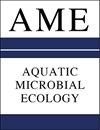Composition and temporal dynamics of sand-dwelling dinoflagellate communities from three Mediterranean beaches
IF 1.1
4区 环境科学与生态学
Q3 ECOLOGY
引用次数: 5
Abstract
Compared to plankton, benthic communities are thought to be heterogeneous among sites and more stable through time; however, benthic protists in general, and sand-dwelling dinoflagellates in particular, have been scarcely studied, and their diversity remains mostly unknown. To test those claims, we studied the diversity, structure and temporal dynamics of benthic dinoflagellate communities in sandy sediments obtained from 3 NW Mediterranean Sea coastal locations during temperate spring and warm summer months. After separating protist cells from the substrate using the seawater-ice method, high-throughput amplicon sequencing of the V4 18S rRNA gene region followed by the analysis of amplicon sequence variants (ASVs) showed similar richness, alpha-diversity, and community composition among sand-dwelling dinoflagellates at the 3 locations. Dinoflagellates affiliating with the Thoracosphaeraceae or Gymnodiniales sensu stricto were highly represented. In contrast, other well-known dinoflagellate taxa, such as Gonyaulacales or Dinophysales, were poorly represented or absent. Dinoflagellate communities showed significant differences between the 2 studied seasons, mainly driven by water temperature. Samples from temperate months had higher diversity and were more dissimilar, while samples from warmer months showed lower diversity and higher similarity. Some species were always present in the community, others only appeared sporadically, and some others showed clear differences between seasons. Our results suggest that large-scale changes (pointing to seasonality) prevail over spatial heterogeneity in shaping community composition. The 3 studied locations had a similar dinoflagellate community composed of sand-dwelling taxa, with many representatives of undescribed species, highlighting the need to further study the diversity of the benthic compartment.地中海三个海滩沙栖鞭毛藻群落组成及时间动态
与浮游生物相比,底栖生物群落被认为是异质的,并且随着时间的推移更加稳定;然而,一般的底栖原生生物,特别是沙栖鞭毛藻,几乎没有被研究过,它们的多样性仍然是未知的。为了验证这些说法,我们研究了在温带春季和温暖夏季从地中海西北部3个沿海地区获得的砂质沉积物中底栖鞭毛藻群落的多样性、结构和时间动态。采用海水冰法将原生细胞从底物中分离出来后,对V4 18S rRNA基因区域进行高通量扩增子测序,并对扩增子序列变异(asv)进行分析,结果显示3个地点的沙居鞭毛藻的丰富度、α -多样性和群落组成相似。胸鳞科鞭毛藻和裸子鞭毛藻均有较高的代表性。相比之下,其他已知的鞭毛类群,如Gonyaulacales或Dinophysales,很少有代表或不存在。两季间鞭毛藻群落差异显著,主要受水温影响。温带月份的样品多样性较高,差异较大,而温暖月份的样品多样性较低,相似度较高。有些物种在群落中一直存在,有些物种只是零星出现,还有一些物种在季节之间表现出明显的差异。我们的研究结果表明,在形成群落组成方面,大尺度变化(指向季节性)优于空间异质性。3个研究地点均有相似的由沙栖类群组成的鞭毛类群落,且有许多未描述物种的代表,表明需要进一步研究底栖动物区室的多样性。
本文章由计算机程序翻译,如有差异,请以英文原文为准。
求助全文
约1分钟内获得全文
求助全文
来源期刊

Aquatic Microbial Ecology
环境科学-海洋与淡水生物学
CiteScore
3.30
自引率
0.00%
发文量
8
审稿时长
3.0 months
期刊介绍:
AME is international and interdisciplinary. It presents rigorously refereed and carefully selected Research Articles, Reviews and Notes, as well as Comments/Reply Comments (for details see AME 27:209), Opinion Pieces (previously called ''As I See It'') and AME Specials. For details consult the Guidelines for Authors. Papers may be concerned with:
Tolerances and responses of microorganisms to variations in abiotic and biotic components of their environment; microbial life under extreme environmental conditions (climate, temperature, pressure, osmolarity, redox, etc.).
Role of aquatic microorganisms in the production, transformation and decomposition of organic matter; flow patterns of energy and matter as these pass through microorganisms; population dynamics; trophic interrelationships; modelling, both theoretical and via computer simulation, of individual microorganisms and microbial populations; biodiversity.
Absorption and transformation of inorganic material; synthesis and transformation of organic material (autotrophic and heterotrophic); non-genetic and genetic adaptation; behaviour; molecular microbial ecology; symbioses.
 求助内容:
求助内容: 应助结果提醒方式:
应助结果提醒方式:


